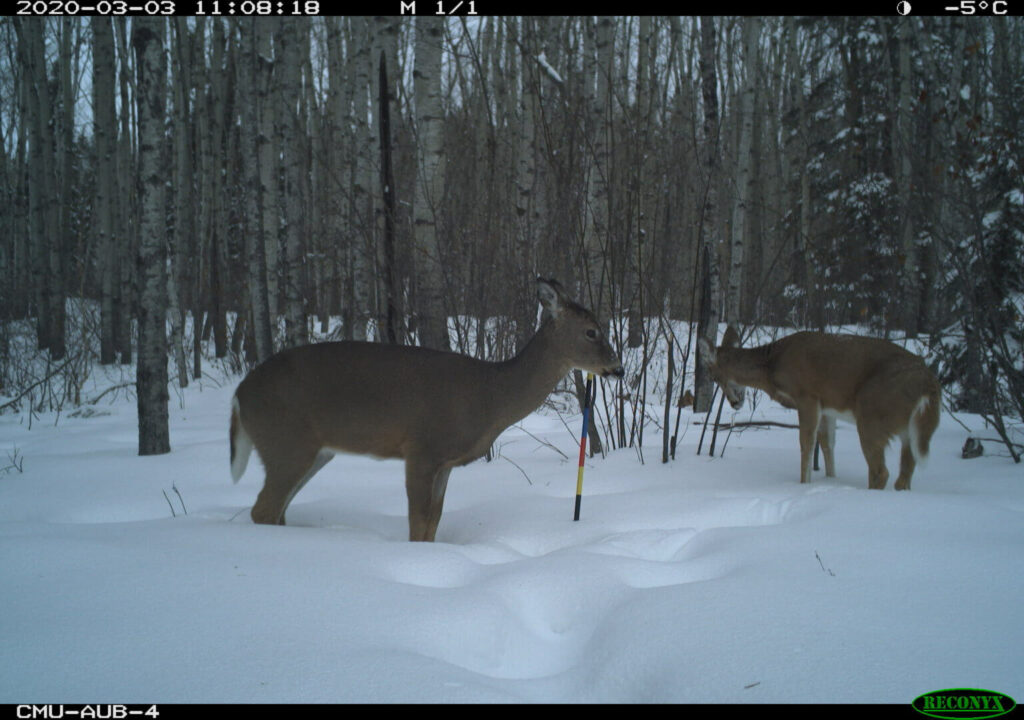The Ecosystem Monitoring Camera Program has been monitoring mammals across northeastern Alberta and northwestern Saskatchewan since 2017. The program is a collaboration with RICC, the University of Alberta, the Government of Alberta, and Cold Lake First Nation.

The program was designed to monitor responses of various species to existing management actions over time. Remote cameras are used to monitor changes in relative abundance and activity levels of ungulates (moose, deer, woodland caribou), predators (bears, wolves, coyotes, lynx, and foxes,) and various medium-sized mammals in the West Side Athabasca River (WSAR), East Side Athabasca River (ESAR), Cold Lake, Richardson and Saskatchewan boreal plains caribou ranges to better understand what management approaches could support caribou recovery.
The success of boreal woodland caribou recovery efforts requires using multiple conservation levers to address increased predation and habitat loss. These conservation levers include habitat restoration and protection, population reduction of alternative prey and predators as well as direct augmentation to caribou populations through programs like maternal penning and conservation breeding. Understanding how the mammalian community responds to caribou recovery actions, and how these various conservation levers combine to influence populations at the range-scale, is necessary.

The Ecosystem Monitoring Camera Program’s goals are threefold:
The first goal is to monitor multi-species responses to caribou management actions over time using a remote camera program. The program specifically monitors changes in relative density/abundance and activity levels of multiple species including ungulates (moose, deer, woodland caribou) and predators (wolves and bears) over time in caribou ranges with:
- predator reductions (East Side Athabasca River [ESAR]),
- habitat restoration and predator reductions (Cold Lake),
- no restoration or predator reduction (West Side Athabasca River [WSAR]) and
- relatively little human habitat-alteration (Saskatchewan Boreal Plains).
The Alberta provincial government began a predator reduction program in the winter of 2017 in ESAR and Cold Lake, which aims to remove all wolves within these caribou ranges during winter. In the Cold Lake caribou range, RICC members have conducted extensive restoration of conventional seismic lines, particularly in the eastern portion of the range where the Cenovus-led Linear Deactivation (LiDEA) program has restored over 200 km of seismic lines. The Saskatchewan Boreal Plains range is thought to act as a “pristine” reference to which Alberta’s ranges can be compared. Monitoring how the mammalian community responds to predator reductions and habitat restoration is imperative to support the directives identified in the federal caribou recovery strategy and draft provincial range plan.

The second goal of the program is to simultaneously clarify the relative influence of human habitat alteration and climate on expanding white-tailed deer densities. White-tailed deer have become increasingly common within caribou range in northern Alberta. These increased white-tailed deer densities have been linked with an increase in wolf densities. Previous studies have speculated that habitat alteration and climate change will combine to influence deer and caribou populations. However, the relative contributions of these impacts are difficult to quantify, primarily because climate and landscape alteration co-vary across much of Canada – winters become more severe and lands less altered by humans as latitude increases.
We placed cameras across similar latitudes throughout each range, allowing us to compare low human habitat alteration (Saskatchewan Boreal Plains) and high habitat alteration (WSAR, ESAR, and Cold Lake), while controlling for latitude. Under both the Habitat Alteration Hypothesis and Climate Hypothesis, deer density is predicted to decline as latitude increases. But, by leveraging the stark contrast in disturbance between Alberta and Saskatchewan, the effect of habitat alteration can be disentangled from latitude in this unique design–habitat alteration differs while latitude, and therefore climate, is held constant across replicates. Under the Habitat Alteration Hypothesis, deer density is predicted to be higher in the highly altered landscape. Conversely, under the Climate Hypothesis, deer density is predicted to not differ across the levels of habitat alteration.

Finally, the third goal is to monitor mammal densities within the Richardson caribou range to collect baseline ungulate and carnivore data before and while white-tailed deer expand into the area, which is at the northern limit of white-tailed deer range. Understanding deer densities over time, and deer co-existence with caribou and the related mammalian community, is necessary to understand the relative role of habitat-mediated and climate-mediated apparent competition.
